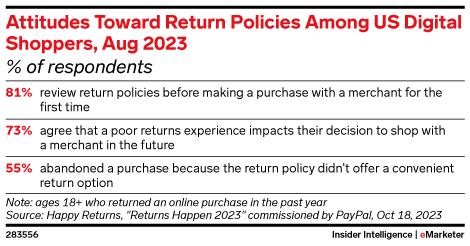Follow these key elements to create a successful return policy.
In the dynamic landscape of e-commerce and retail, a company's return policy plays a pivotal role in shaping customer satisfaction, influencing purchasing decisions, and ultimately impacting both returns and sales. A well-crafted return policy is not merely a set of rules but a strategic tool that can enhance customer trust, boost brand loyalty, and drive revenue. In this blog post, we will delve into the intricate relationship between a company's return policy and its effects on returns and sales.
Building Trust through Transparency
The cornerstone of a successful return policy lies in transparency. When customers are well-informed about a company's return procedures, they feel more secure and confident in their purchasing decisions. Clearly communicating return conditions, including time frames, eligibility criteria, and any associated costs, establishes trust and reduces the uncertainty that often leads to returns. An effective return policy should include:
-
-
- Clear and Concise Terms: Clearly communicate the conditions for returns, including time frames, eligibility criteria, and any associated costs. This transparency eliminates uncertainty and establishes trust.
- Transparent Communication: Ensure that the return policy is easily accessible on the company's website and at various touchpoints during the purchasing process. Transparency builds confidence and demonstrates a commitment to customer satisfaction.
- Clear and Concise Terms: Clearly communicate the conditions for returns, including time frames, eligibility criteria, and any associated costs. This transparency eliminates uncertainty and establishes trust.
-
Consider a scenario where a customer is unsure about the return process or worried about hidden fees. A transparent return policy eliminates such concerns, fostering a positive customer experience and encouraging repeat business. Trust is a currency in the world of commerce, and a clear and honest return policy is a powerful way to earn and maintain it.
Impact on Customer Satisfaction
Customer satisfaction is directly tied to the ease and simplicity of the return process. A flexible and hassle-free return policy contributes significantly to a positive shopping experience. When customers know they can easily return a product that doesn't meet their expectations, they are more likely to make a purchase in the first place. An effective return policy should focus on:
-
-
- Ease of Returns: Strive for a hassle-free return process. Provide customers with user-friendly online interfaces, automated return systems, and clear instructions to simplify the return journey.
-
-
-
- Lenient Return Window: Offer a reasonable return window, allowing customers ample time to assess their purchase and return it if necessary. A flexible return window enhances customer satisfaction and encourages repeat business.
-
A rigid or complicated return policy, on the other hand, can lead to frustration and dissatisfaction. Customers may hesitate to buy if they perceive the return process as cumbersome or restrictive. In the long run, a dissatisfied customer is unlikely to become a repeat customer, and negative word-of-mouth can tarnish a brand's reputation.

Driving Sales Through Confidence
An effective return policy can be a powerful sales tool. Offering a lenient return window and a straightforward process reassures customers that they can rectify a purchase if it doesn't meet their needs. This reassurance often leads to increased confidence in making a purchase, especially when shopping online where customers cannot physically inspect the product before buying. To drive sales, ensure that the return policy:
-
-
- Conveys Confidence: Express confidence in the quality of your products by offering a lenient return policy. This reassures customers, boosting their confidence and encouraging them to make a purchase.
- Customer-Centric Approach: Adopt a customer-centric approach by prioritizing customer satisfaction over stringent rules. Consider offering perks such as free return shipping, no restocking fees, and instant refunds to enhance the overall shopping experience.
-
Companies that are confident in the quality of their products often adopt customer-friendly return policies. This confidence is communicated to the customer, creating a positive perception of the brand. Customers are more likely to make a purchase when they feel assured that the company stands behind its products and is willing to address any issues that may arise.
Balancing Act: Preventing Abuse While Fostering Loyalty
While a lenient return policy can drive sales and boost customer satisfaction, companies must strike a balance to prevent abuse. A clear return policy should outline acceptable reasons for returns and include measures to prevent fraudulent or excessive returns. Striking this balance is crucial for maintaining profitability while still providing exceptional customer service. To strike a balance between preventing abuse and fostering loyalty, an effective return policy should:
-
-
- Define Acceptable Reasons for Returns: Clearly outline acceptable reasons for returns to prevent abuse. This could include defects, damaged items, or discrepancies in product descriptions.
- Implement Monitoring Systems: Use technology to track return patterns and identify potential abuse. Automated systems can help flag suspicious activities and protect the company from fraudulent returns.
-
Implementing a system that tracks return patterns and identifies potential abuse can help companies identify and address fraudulent behavior. At the same time, offering perks such as free return shipping, hassle-free returns, and no restocking fees can enhance customer loyalty and incentivize repeat business.
The Role of Technology in Streamlining Returns
In the digital age, technology has become a key enabler in streamlining the returns process. Implementing user-friendly online interfaces and automated return systems can significantly enhance the customer experience. This includes providing return labels, instant refunds, and real-time tracking of return shipments. In the digital age, technology has become a key enabler in streamlining the returns process. To leverage technology effectively:
-
-
- User-Friendly Interfaces: Implement user-friendly online interfaces that simplify the returns process. This includes providing return labels, real-time tracking, and automated communication to keep customers informed.
- Automation for Efficiency: Utilize automation to streamline administrative tasks associated with returns. Automation speeds up the process, leading to quicker resolutions and a more positive customer experience.
-
Companies that leverage technology to simplify returns demonstrate a commitment to customer satisfaction. Automation not only reduces the administrative burden on the company but also speeds up the return process, leading to quicker resolutions for customers. The convenience afforded by technology contributes to a positive overall impression of the brand.
Conclusion
In conclusion, a company's return policy is a critical component of its customer experience strategy. The impact of a well-crafted return policy extends beyond the returns process itself; it influences customer trust, satisfaction, and purchasing decisions. By prioritizing transparency, flexibility, and the strategic use of technology, companies can harness the power of their return policies to drive sales, build brand loyalty, and thrive in the competitive world of e-commerce and retail. The return policy is not merely a set of rules—it's a dynamic tool that can shape the customer journey and contribute to the long-term success of a business.
Crafting an effective return policy involves a thoughtful combination of transparency, customer-centricity, and the strategic use of technology. The impact of a well-crafted return policy extends beyond the returns process itself; it influences customer trust, satisfaction, and purchasing decisions. By prioritizing these key components, companies can harness the power of their return policies to drive sales, build brand loyalty, and thrive in the competitive world of e-commerce and retail. The return policy is not merely a set of rules—it's a dynamic tool that can shape the customer journey and contribute to the long-term success of a business.
The Returnalyze Intelligent Dashboard can identify issues that are hindering a loyalty program’s profitability while highlighting opportunities that improve customer lifetime value and create additional loyal customers.
Along with access to detailed analytics, a partnership with Returnalyze comes with step-by-step guidance and expert data analysis. That means you can leverage this information to create and implement data-driven solutions.
If you'd like to see how our intelligent dashboard can help you leverage return season data, schedule a demo or contact our team today.




